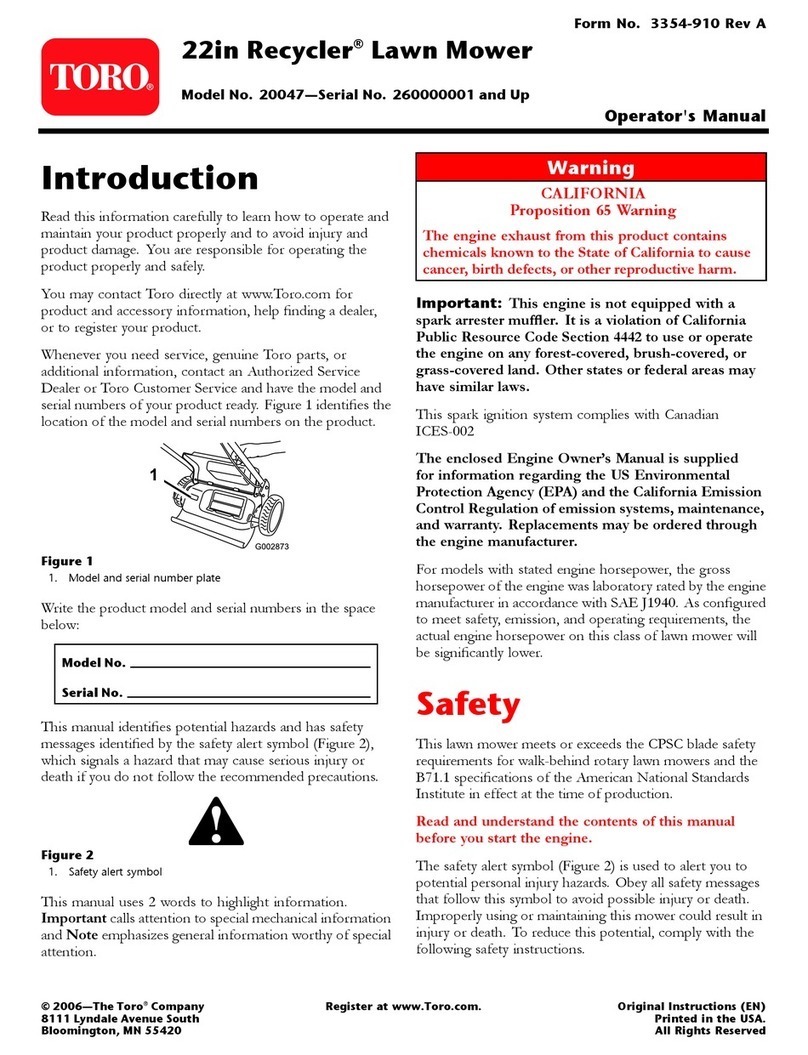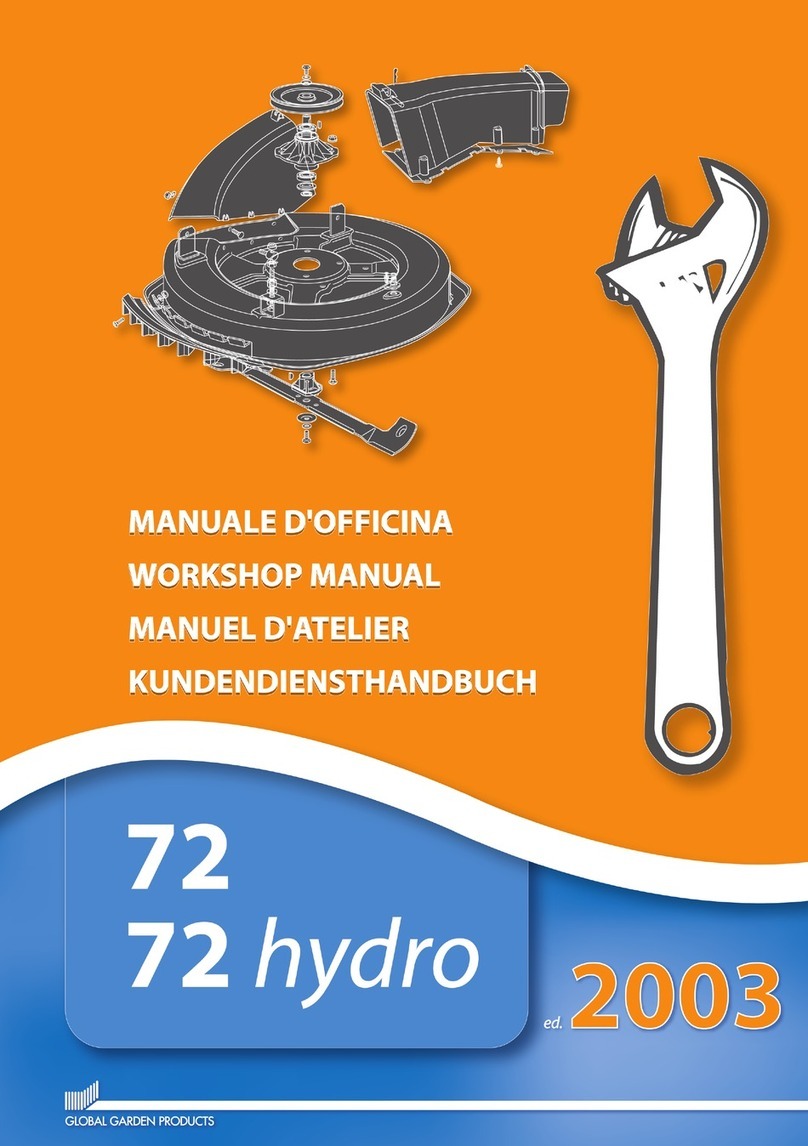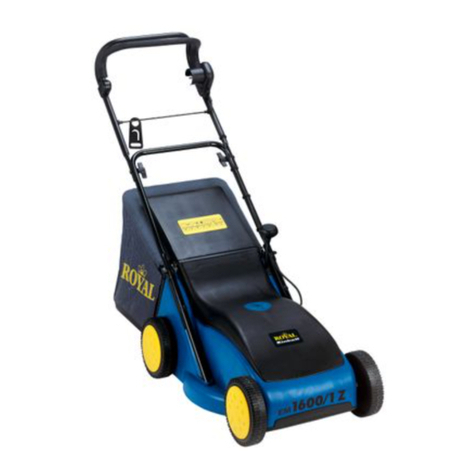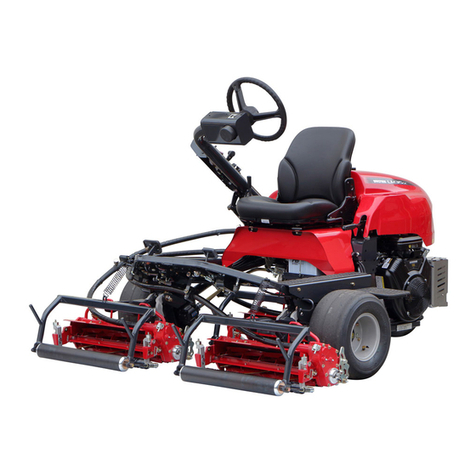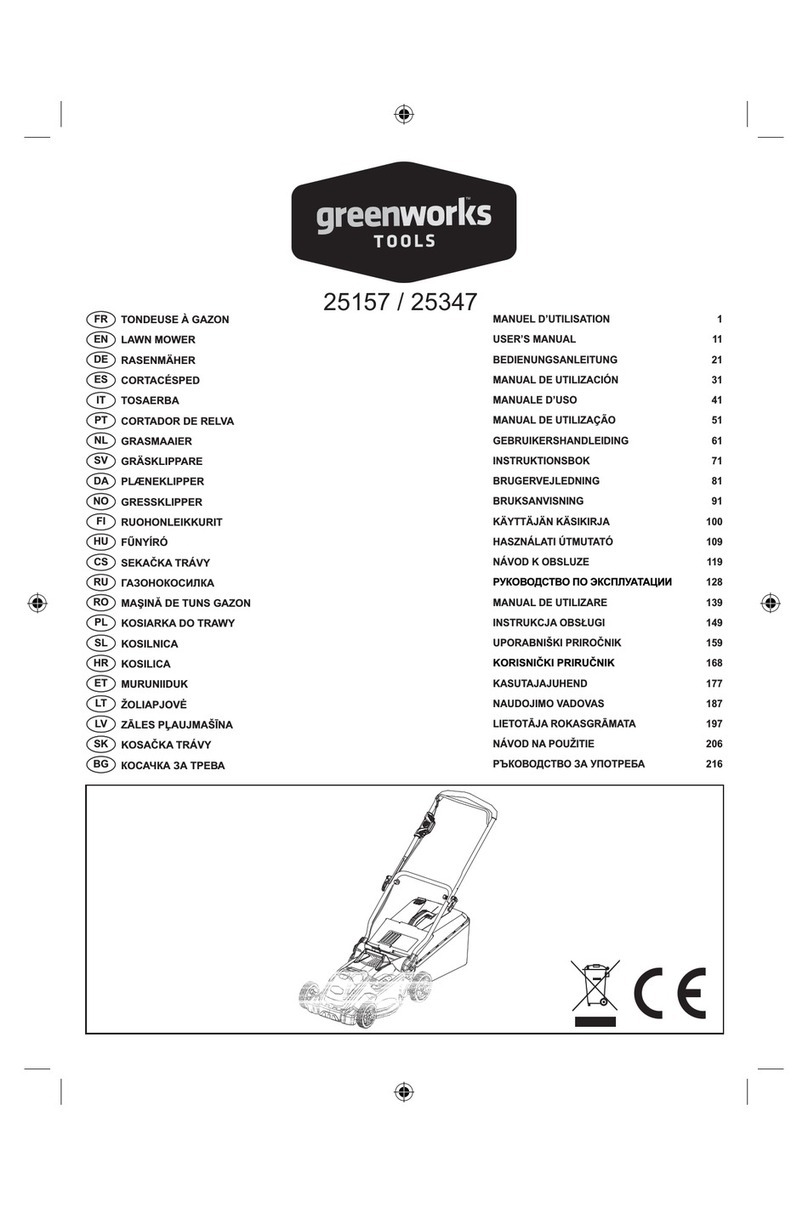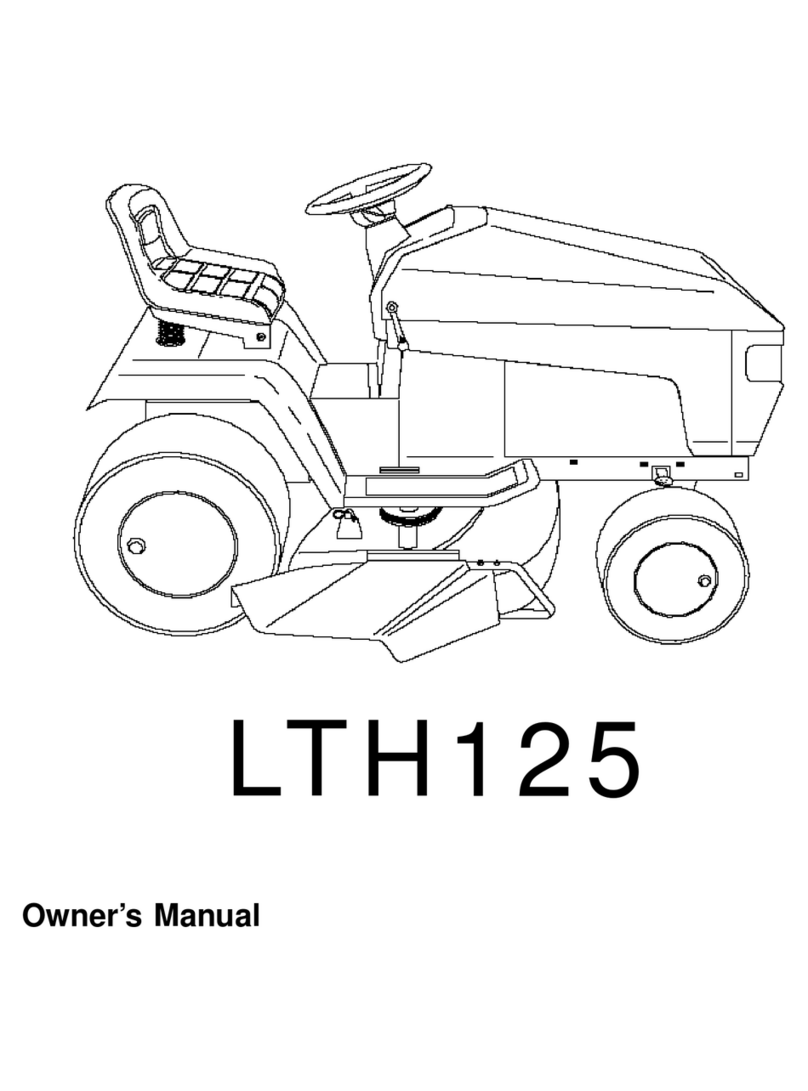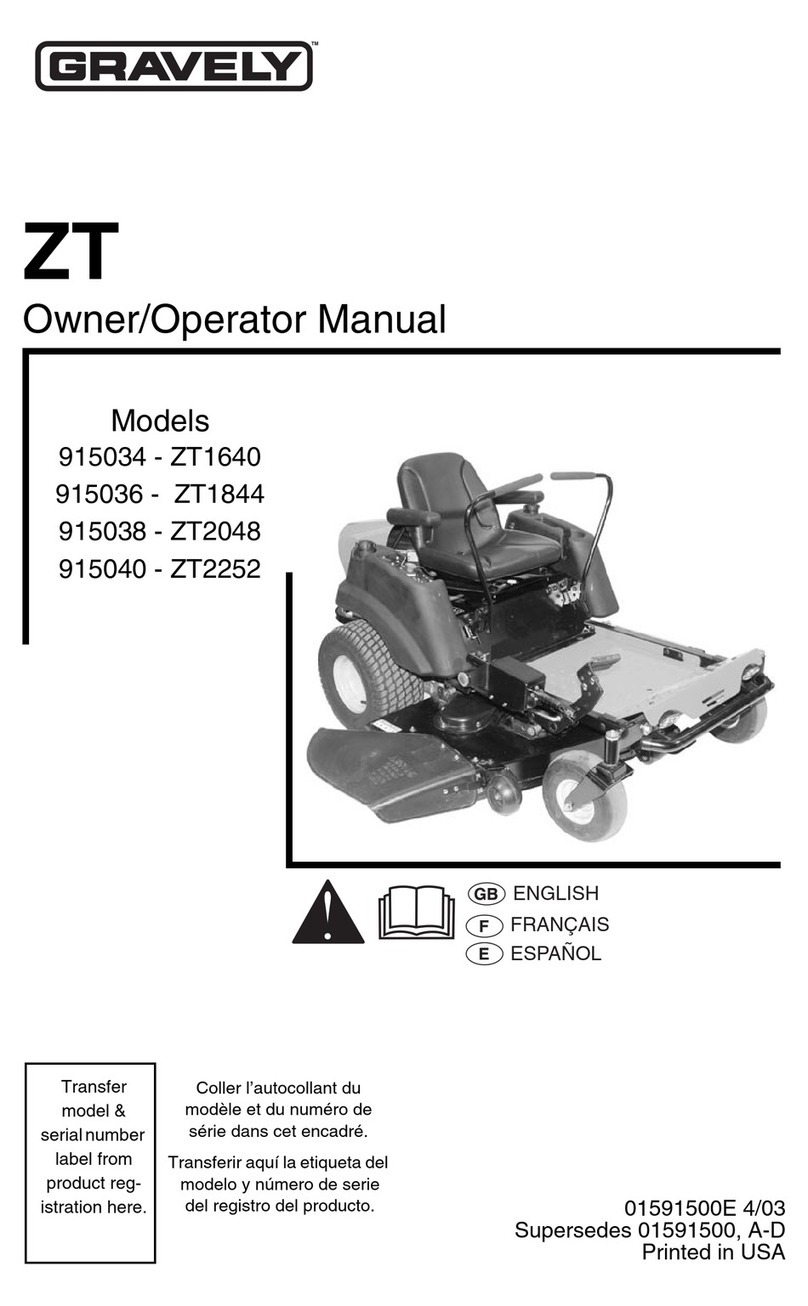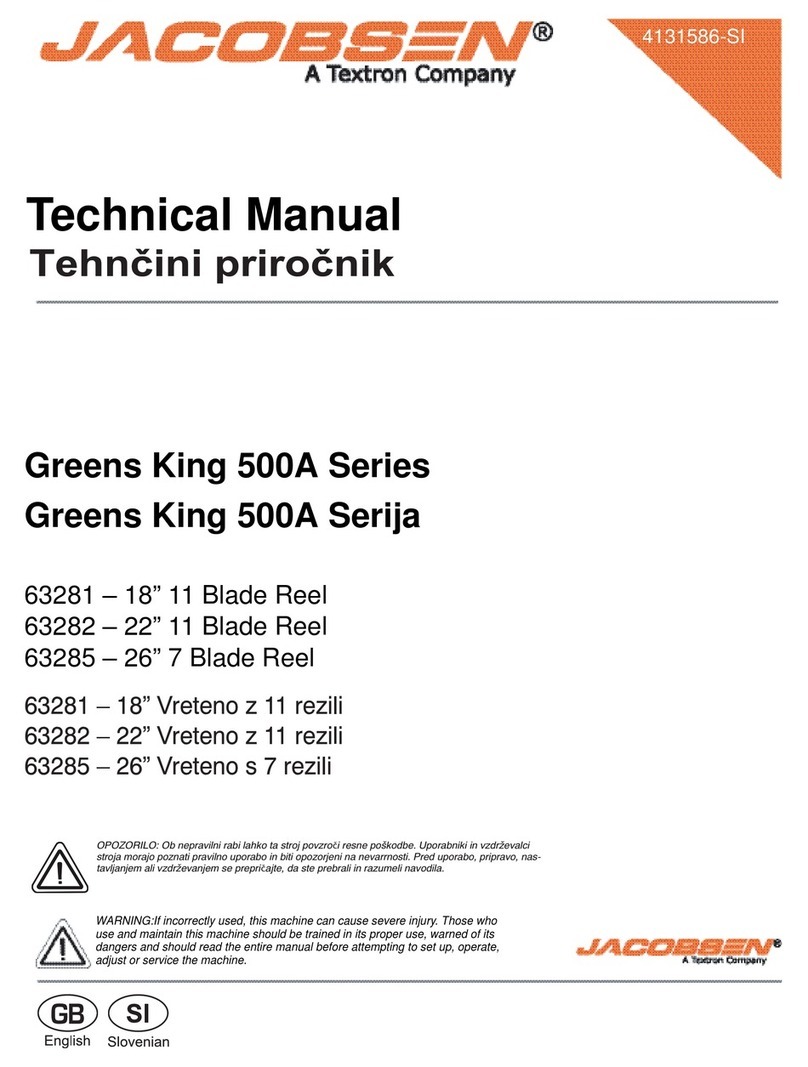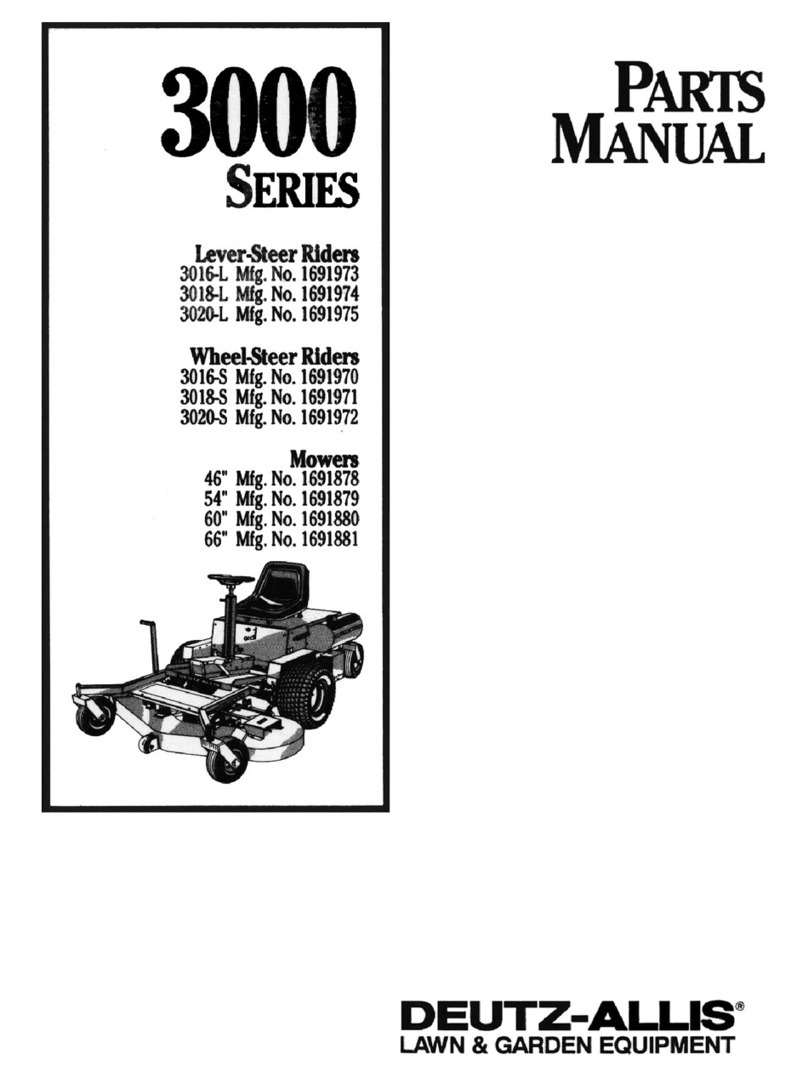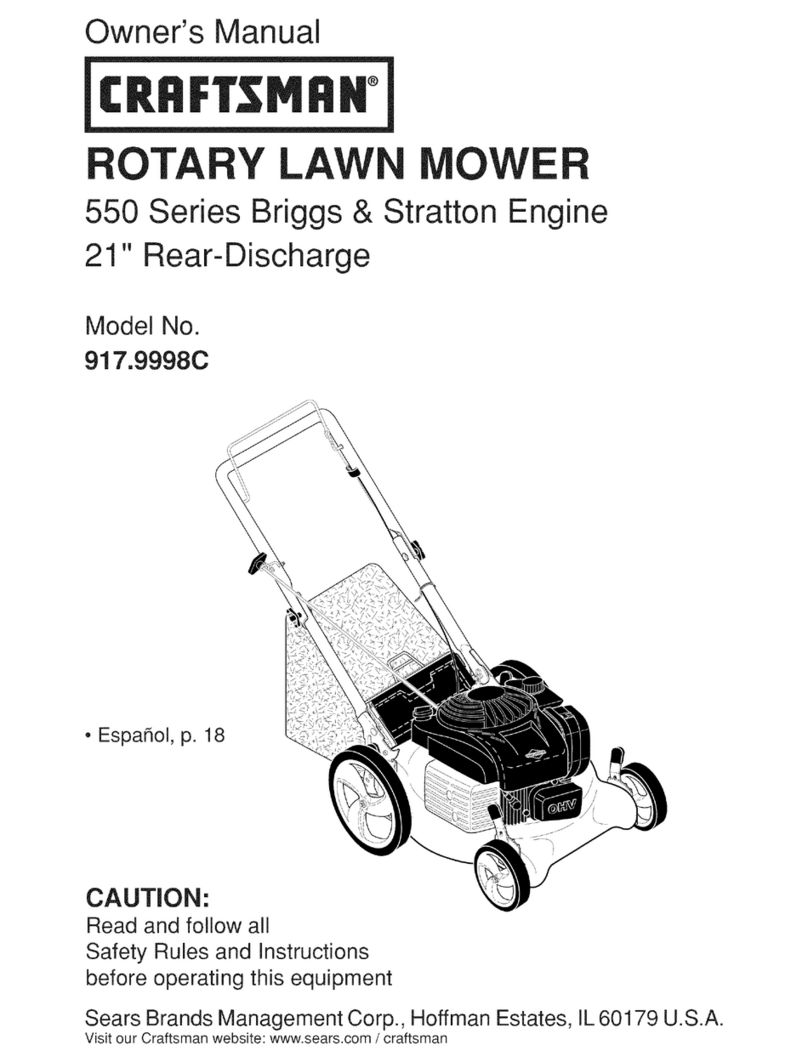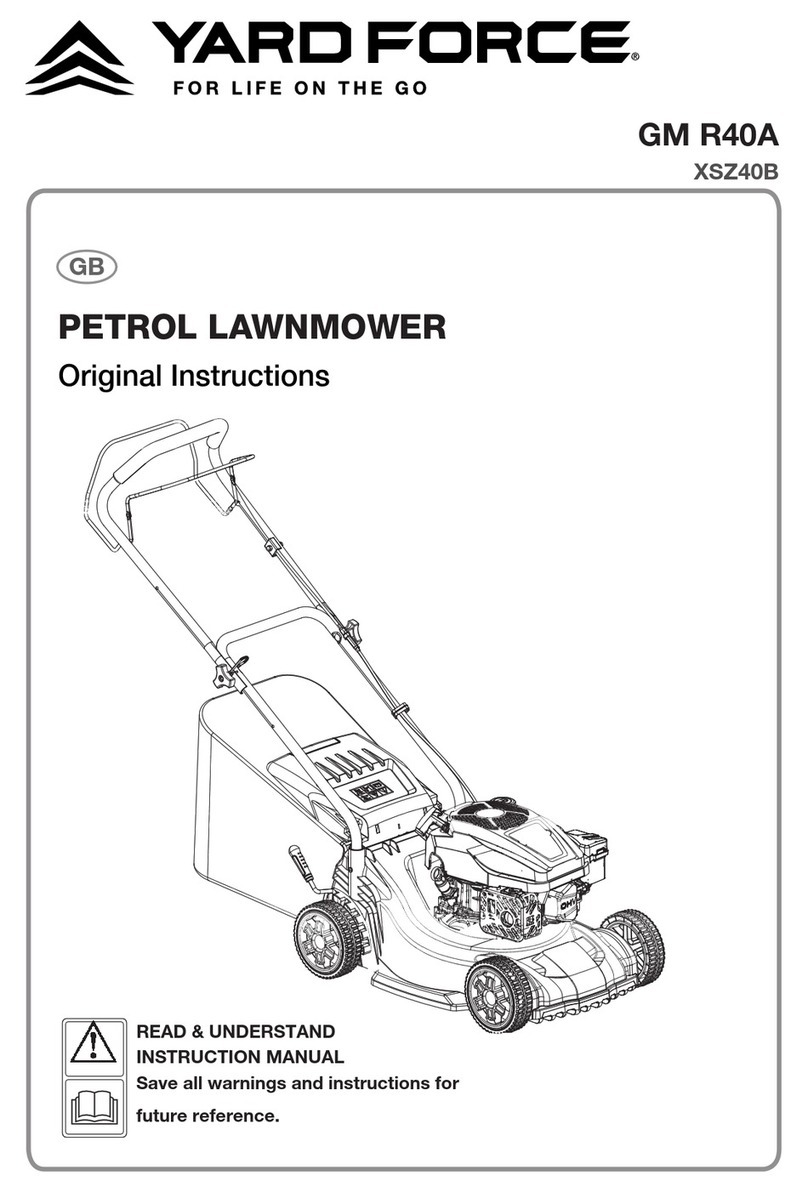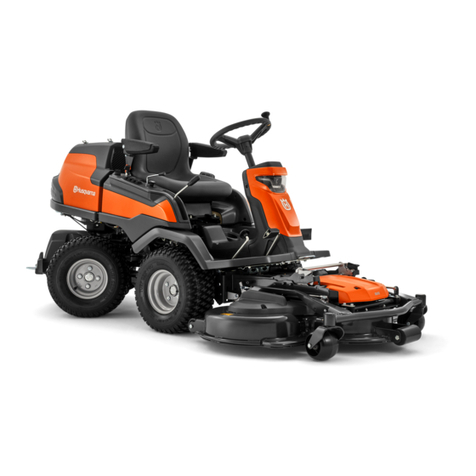Allett Stirling 43 Aerator Cartridge User manual

F016J13542-A ISSUE 28-01-22 SE
1
56 Volt Lithium-Ion Battery Cordless Cylinder Mower
Model Numbers: STIR43 / 1 and STIR51 / 1
OPERATOR’S MANUAL
For serial numbers: STIR43/1-21-0001 & STIR51/1-21-0001 onward
Original instructions: English version
Allett Limited, Regal House, Airfield Industrial Estate, Hixon, Stafford, ST18 0PF, United Kingdom
Tel: +44 (0) 1889 271503 sales@allett.co.uk www.allett.co.uk
For Allett spare parts tel: +44 (0) 1889 27209

F016J13542-A ISSUE 28-01-22 SE
2
READ THIS MANUAL BEFORE USING AN ALLETT STIRLING 43 OR 51 CYLINDER MOWER
YOUR SAFETY IS INVOLVED
IT IS ESSENTIAL THAT OPERATORS STUDY THIS DOCUMENT FOR THEIR OWN SAFETY

F016J13542-A ISSUE 28-01-22 SE
3
Operating controls
①
②
③
④
⑤
⑥
⑦
⑧
⑨
1) Handle
2) Battery dock
3) HiteRite™ grip
4) Cartridge clamp
5) Grass bag
6) Front roller
7) Cartridge securing lever
8) Quick adjust lever (handle pivot)
9) Handle locking clamp
10) RotoShift™ grip
11) Cylinder bail bar
12) Safety button
13) RotoShift™ switch
14) Battery release button
15) Power indicator
16) Isolation key
⑭
⑮
⑯
EGO CH2100E -Standard Charger
EGO CH5500E -Rapid Charger
EGO BA2800T 5.0Ah -Battery
EGO BA5600T 10.0Ah -Battery
④

F016J13542-A ISSUE 28-01-22 SE
4
x4
!
A

F016J13542-A ISSUE 28-01-22 SE
5
③
②
①
2
3
1
B
C
A
E
D
A

F016J13542-A ISSUE 28-01-22 SE
6
K1
K2
K3
K4
F
A
G
A
H
I
J
K
L

F016J13542-A ISSUE 28-01-22 SE
7
M
O
P
Q
22
21
20
18
18
19
1
2

F016J13542-A ISSUE 28-01-22 SE
8
Intended use
This product is intended for domestic lawnmowing on good quality frequently mown turf where the grass height is
less than 50mm.
Introduction
This manual gives instructions on the correct assembly and safe use of your machine. It is important that you read
these instructions carefully. When fully assembled, the machine is greater than 20kg in weight. If necessary, obtain
assistance to remove from it from the packaging. Take care if carrying the mower as the blades are sharp.
The Stirling mower has been designed predominantly as a lawn mower. However, the base unit can accept a range
of interchangeable cartridges to cover a number of turf management tasks. These can be purchased separately
form Allett Ltd or your local Allett dealer.
A Stirling mower should be operated, serviced, and repaired only by persons who are familiarwith its characteristics
and who are familiar with the relevant safety procedures.
The safety precautions outlined in this manual and all other generally recognised regulations on safety must be
observed at all times.
Any modifications carried out to a Stirling mower will relieve Allett Limited of liability for any resulting damage or
injury.
Allett Limited reserves the right to amend product specifications without prior notification.
Model type and serial number
The model can be found in two places:
1. On the top cover of the mower.
2. On the serial number plate located on the right side of the mower chassis.
The serial number can be found on the serial plate.
Please enter your information below
Model: Stirling 43 Stirling 51
Serial Number: Mode/Type –Date –Serialised No. ___________________________________________
Safety Notes
Important! Warning! Read these instructions carefully, be familiar with the controls and the proper use of the
lawnmower.
Keep these instructions for future reference.

F016J13542-A ISSUE 28-01-22 SE
9
Explanation of symbols on the lawnmower
General hazard safety alert
Read instruction manual
Beware of thrown or flying objects
Keep bystanders at a safe distance from machine
Switch off and remove isolation key before adjusting, cleaning and before leaving
the lawnmower unattended for any period.
Sharp blade(s). Beware of severing toes or fingers.
Wait until all machine components have completely stopped before touching them.
The blades continue to rotate after the machine is switched off, a rotating blade can
cause injury.
Never allow children to use the lawnmower, children should be supervised to ensure
they do not play with the machine. Always remove the isolation key, even when in
storage.
Cartridge securing lever Height of cut / depth of cultivation
Power indicator status

F016J13542-A ISSUE 28-01-22 SE
10
Never allow people unfamiliar with these instructions to use the lawnmower.
Local regulations may restrict the age of the operator.
This machine is notintended for use by children orby personswith reduced physical, sensoryor mental capabilities,
or lack of experience and knowledge unless they have been given supervision or instruction concerning the use of
the machine by a person responsible for their safety.
Never mow while people, especially children or pets, are nearby.
The operator or user is responsible for accidents or hazards occurring to other people or their property.
Do not operate the lawnmower when barefoot or wearing open sandals, always wearsubstantial footwear and long
trousers.
Thoroughly inspect the area where the lawnmower is to be used and remove all stones, sticks, wires, bones and
other foreign objects.
Before using, always visually inspect to see that the blades, blade bolts and cutter assembly are not worn or
damaged.
Replace worn or damaged blades and bolts in sets to preserve balance.
Mow only in daylight or in good artificial light.
Avoid operating the lawnmower in wet grass, where feasible.
Walk, never run.
Mowing on banks can be dangerous:
- Mow across the face of slopes –never up and down.
- Always be sure of your footing on slopes or wet grass.
- Exercise extreme caution when changing direction on slopes.
- Do not mow excessively steep slopes.
- Use extreme caution when stepping back or pulling the lawnmower towards you.
- Never mow by pulling the mower towards you.
Stop the blades if the lawnmower has to be tilted for transportation when crossing surfaces other than grass and
when transporting the lawnmower to and from the area to be mowed.
Do not tilt the machine when starting or switching on the motor, except if the machine has to be tilted for starting in
long grass. In this case, do not tilt it more than necessary and tilt only the part which is away from the operator.
Always ensure that both hands are in the operating position before returning the machine to the ground.
Never operate the appliance with defective guards or shields, or without safety device, for example deflectors
and/or grass catchers in place.
Switch on the lawnmower according to instructions and with feet well away from the blades.
Disengage all blade and drive clutches before starting the motor.
Keep clear of discharge opening at all times.
Always stand clear of the discharge zone when operating the machine.
Never pick up or carry the lawnmower while the motor is running.
Do not put hands or feet near, or under, rotating parts while the lawnmower is being operated.
Be careful during adjustment of the lawnmower to prevent entrapment of the feet and hands between moving
blades and fixed parts of the lawnmower.
Always wear gloves if carry out maintenance near the sharp blades.

F016J13542-A ISSUE 28-01-22 SE
11
Remove the isolation key and batteries:
- Whenever you leave the machine
- Before clearing a blockage
- Before checking, cleaning, or working on the lawnmower
- After striking a foreign object. Inspect the lawnmower for damage and make repairs as necessary
- If the lawnmower starts to vibrate abnormally (check immediately).
- When in storage or being folded for storage
- Before transporting the machine
Keep all nuts, bolts, and screws tight to be sure that the lawnmower is in safe working condition.
Check the grass catcher frequently for wear or deterioration.
Replace worn or damaged parts for safety.
Ensure replacement parts fitted are approved
TECHNICAL DATA
Designation:
Stirling 43 battery
Cylinder lawnmower
Stirling 51 battery
Cylinder lawnmower
Machine Model/type
STIR43/1
STIR51/1
Voltage (Max V)
56V DC
56V DC
Blade width (cm)
43
51
Height of cut (mm)
10-50
10-50
Grass box capacity (l)
62l
70l
Self-propelled
✓
✓
Weight (kg)
53kg
57kg
IP rating
IPX4
IPX4
DELIVERED ITEMS
Lawnmower with cutting cylinder cartridge
Handle assembly
Grass bag frame
2 x grass bag cross bars
Fabric grass bag
Operator’s Manual, QuickStart sheet, Product registration card
4mm Allen key
Spanner
1 x Cover plate
4 x M6x50mm screws
2 x Auxiliary plastic wheels & stub axles
Battery (If mower/battery/charger bundle purchased)
Charger (If mower/battery/charger bundle purchased)

F016J13542-A ISSUE 28-01-22 SE
12
ASSEMBLY
Assembling the handle to the mower (See Fig. A)
WARNING! - Remove the battery from the mower to prevent accidents during assembly
1. Locate the electrical connector on the handle, next locate the mating connector one on the mower. The
connector on the mower will be on the rear right-hand side near the base of the top cover. Push the
connectors together making sure the mating orientation is correct and the lock is secure.
2. Start with the handle lying flat on the ground. Next locate the slots in the chassis and the blocks where
the handle will be mounted. It is important that the handle electrical wiring goes through the right-hand
slot in the chassis first (right hand from operators’ position). With the wiring in place position the handle
on the mower, pass the handle through the slots so it rests in the mounting blocks. Tuck any spare cable
in the tray below the mounting blocks.
3. Pivot the handlebars up and lock in the upright storage/maintenance position using the quick adjust lever
(see section on Handle height adjustment)
4. Fit the cover plate to secure the handle to the mower. Use 4 x M6 x 50mm fasteners, 4 x M6 washers
and 4 x M6 nyloc nuts. Tighten the nuts with a minimum torque of 12Nm
Assembling the grass bag (See Fig. B)
How to assemble the grass bag
1. Fold both side frames out
2. Attach the cross bars to secure the frame in the open position, please take note of cross bar orientation
in Figure B
3. Fit the fabric grass bag over the frame so that the solid material base is opposite the handle, secure with
the plastic clips
How to fit the grass bag to the mower (See Fig. C)
Locate the grass bag frame into the slots on both sides of the mower chassis (See Fig C)

F016J13542-A ISSUE 28-01-22 SE
13
BATTERIES AND CHARGING
Checking battery capacity (See Fig. D)
Press the power button on the battery (See Figure D) to display the charge level or its working condition via the 5
LED indicator. The charge levels are as follows:
Battery charge
level / working
condition
5-LED
indicator
Remarks
80% ≤ Charge
level ≤ 100%
5-LED shining green
60% ≤ Charge
level < 80%
4-LED shining green
40% ≤ Charge
level < 60%
3-LED shining green
20% ≤ Charge
level < 40%
2-LED shining green
10% ≤ Charge
level < 20%
1-LED shining green
Charge level < 10%
1-LED flashing red
Low voltage
5-LED flashing red
The battery pack is
nearly depleted and
needs to be charged
immediately
Over temperature
5-LED shining red
Cool the battery
pack until the
temperature drops
below 67°C.

F016J13542-A ISSUE 28-01-22 SE
14
Charging the battery
NOTE: The battery is not shipped fully charged. It is recommended to fully charge before use to ensure that
maximum run time can be achieved. This lithium-ion battery will not develop a memory and may be charged at any
time. In normal conditions a 5Ah battery (BA2800/BA2800T) can be full charged in approximately 100 mins with
the standard charger (CH2100E).
To charge the battery proceed as follows:
Plug the charger into a Mains AC power outlet (220-240V ~ 50Hz)
1. Insert the battery into the charger
2. When the battery pack is charging, the green LED on the charger will flash and the power indicator on the
battery will flash.
3. When the battery pack is fully charged, the green LED will stop flashing and will shine green continuously.
The power indicator on the battery pack will go out. Wait until the cooling fan stops, remove the battery
pack from the charger and disconnect the charger from the power supply.
4. It is good practice to unplug the charger and remove the Lithium-Ion battery pack when not in use.
For further information please refer to the Operator’s manual for the battery
Isolation key
Battery-operated products do not have to be plugged into an electrical outlet; therefore, they are always in operating
condition. Be aware of possible hazards when using the lawnmower, always remove the isolating key (16) when
leaving the lawnmower unattended and never let children play with the machine. Following this rule will reduce the
risk of electric shock, fire, or serious injuries.
Inserting and removing the battery from the mower (See Fig. E)
WARNING: If any parts are broken or missing, do not attempt to attach the battery pack to the mower or operate
the mower until the broken or missing parts are replaced. Failure to do so could result in serious injury.
To insert:
Align the raised ribs on the battery pack with the mounting slots on the battery compartment
Push the battery pack fully into the battery dock until you hear a “CLICK”, make sure the battery is secured into the
mower before starting
To remove:
Depress the battery-release button in the battery dock.
Pull the battery out of the battery dock
Usage time
The area cut and therefore battery duration is dependent on your lawn conditions. Mowing low in wet, dense grass
will reduce the run time. To increase battery life, it is recommended to:
1. Only take ⅓ of the plant height off in a single cut, this will mean mowing frequently at least once per week.
2. Use higher heights of cut, 25mm (1”) as a minimum, any lower and the grass plant can
be very dense.
3. Keep the blades sharp and regularly serviced. Blunt or damaged blades will decrease battery life.
Following the recommendations above in dry conditions your mower should cover an area of
approximately 800m2or run for 30 minutes on a new, fully charged 5 Ah battery.

F016J13542-A ISSUE 28-01-22 SE
15
BATTERY AND CHARGER RECOMMENDATIONS
The charger is for indoor use only
Recharge only with the charger specified by the manufacturer. A charger that is suitable for one type of battery
pack may create risk of fire when used with another battery pack.
Use power tools only with specifically designated battery packs. Use of any other battery packs may create risk of
injury and fire.
When battery pack is not in use, keep it away from other metal objects, like paper clips, coins, keys, nails, screws
or other small metal objects that can make a connection from one terminal to another. Sorting the battery terminals
together may cause burns or a fire.
Under abusive conditions, liquid may be ejected from the battery; avoid contact. If contact accidentally occurs, flush
with water. If liquid contacts eyes, additionally seek medical help. Liquid ejected from the battery may cause
irritation or burns.
Do not use a battery pack or tool that is damaged or modified. Damaged or modified batteries may exhibit
unpredictable behaviour resulting in fire, explosion or risk of injury.
Do not expose a battery pack or tool to fire or excessive temperature. Exposure to fire of temperature above 130°C
may cause explosion.
Protective circuit
The battery includes a protection circuit that will immediately turn off the battery should its temperature exceed
70°C. To warn of this event the power indicator on the mower will shine orange and the LED on the battery will
flash. Stop using the mower and wait until the battery cools down to approximately 67°C before restarting the
mower.
The mower has built-in overload circuit protection. When the mower is overloaded, the motor will stop and the
power indicator on the mower will flash orange. If this occurs, stop using the mower and remove the battery.
Consider making the following adjustments/checks:
Check the rollers, rake, and cartridge for a build-up of material
Increase height of cut to take less material off
Set cylinder to bottom blade (reel to bed knife) contact to be lighter
Reduce the depth of cultivation if using a soil engaging cartridge
Slow down forward speed

F016J13542-A ISSUE 28-01-22 SE
16
Power indicator LED (15)
The mower is equipped with a power indicator to indicate the charge status of the battery pack and the working
status of the mower. The power indicator will illuminate when the cylinder/reel is rotating. Below is a description
of possible status meanings:
Power Indicator on Mower
Meaning
Action
Shining green
Mower is working properly
N/A
Flashing green
Handle is in storage/maintenance
position or cartridge securing lever is
not in the proper position
Check quick-adjust Lever and move
the cartridge lever to the fully locked
position
Flashing red
The battery is depleted
Stop the mower and charge the
battery pack
Solid orange
The mower is overheated
Remove the battery from the mower,
move them to the shade and cool for
at least 15 minutes
Flashing orange
The mower is overloaded
Slow down your pace or raise up the
cut height to decrease the load
Red and green flashing
alternately
Communication timeout
Contact Allett
Starting and stopping (See Fig. F –I)
The blade continues to rotate for a few seconds after the machine is switched off. Allow the motor/blade to stop
rotating before switching “on” again. To aid starting when using a cultivation cartridge push the handle (1) down
lift the front wheels/roller from the floor.
The cutting blades and self-propel function are independent of each other and may be operated individually. For
example, it is good practice when transporting the mower to have the blades turned off.
NOTICE: The cutting blades cannot be started unless:
The handle is locked into one of the three operating positions, see “handle height adjustment”.
The cartridge securing lever is fully forward and retaining the cartridge securely
NOTICE: To prevent serious injury, we recommend that you start the mower with self-propelled function off.
To Start the cutting blades (Fig. F)
Make sure there is a battery in the battery dock (2) and the isolation key (16) is in the key slot.
1. Depress the safety button (12) down.
2. With the safety button (12) depressed, pull the bail switch (11) upward to meet the handle and release
the safety button.
To Stop the cutting blades (See Fig. H)
Fully release the bail switch, the electric brake in the Automatic Braking Mechanism will stop the blade rotation
within 3 seconds of the bail switch release.
It is good practice to turn the RotoShift™ grip off until it can’t be rotated.
To Start the self-propel function (See Fig. G)
1. Press one of the self-propel switches (13).
2. Turn the RotoShift™grip (10) until you hear a “click”.

F016J13542-A ISSUE 28-01-22 SE
17
To turn the self-propel off
Release the self-propel switch and turn the RotoShift™ grip off until it can’t be rotated. (Fig. I)
ADJUSTMENTS
Speed adjustment
The speed of the self-propel drive can be adjusted to suit your walking pace by turning the RotoShift grip forwards
(see Fig. G). The Self-propel speed is independent of the cutter speed.
For cultivation operations it is recommended to use a relatively slow forward speed to maximise the effectiveness.
Handle height adjustment
WARNING: Do not attempt to start the mower until the handle has been locked at one of the lower 3 pre-set
operating positions K1, K2, K3 in Fig K. The upper most position K4 is a storage/maintenance position. The mower
will not operate when the handle is in the storage/maintenance position K4.
To adjust the foldable handle, proceed as follows:
1. Press and hold the quick adjust lever (8) to release the handle lock.
2. Pivot the handle gently into the required position then release the lever.
3. Make sure the lock pin is engaged in one of the different holes K1, K2, K3, K4 as shown in Fig K.
Handle telescopic adjustment (See Fig. J & L)
To extend the handlebars pull both locking clamps out, raise or lower the handlebar section to one of the 3 available
positions. To secure the adjustment press both locking clamps in, making sure the holes line up for the clamping
pins.
Height of cut adjustment (See Fig. M)
Your mower has an infinitely adjustable height of cut between 10 - 50 mm for mowing grass, for sports surfaces a
lower height of cut is achievable with the 10-blade cartridge and sports blade option. Your mower can use cultivation
cartridges (purchased separately) to a maximum depth of 15mm below the surface.
The height of cut is adjusted by turning the knob (7) at the right-hand side of the machine. The comb will also
require adjustment, see “Comb Adjustment”. The numbered scale on the side of the mower can be used as a guide
for either cut height shown in mm on the Left or cultivation depth shown in mm on the right.
It is advised to start high and work down to your required cut height. Never take more than 1/3 of the plant height
off in one go.
Comb adjustment (See Fig. N)
Your mower is fitted with an adjustable comb (22) which can be used on the lower heights of cut. It is set by
loosening the screws (21) and rotating the comb until the tines are 6-12mm (¼” – ½”) above the ground. You may
need to re-adjust after changing the height of cut. Take care not to set the comb too deep, as this could cause
damage to either your mower or lawn.
Cutting long grass –side wheel kit (See Fig. N)
Your mower is fitted with a full width front roller which is suitable for normal smooth lawns. For cutting longer
(>50mm, >2”), coarse grass a side wheel kit can be fitted. To fit this kit, proceed as follows:
1. Tilt the mower back and wedge securely.
2. Remove the front roller/comb assembly by removing screw (20) and removing screw (21) on both sides.
3. Fit the side wheel (18) on to the side wheel spindle (19).
4. Fit each side wheel assembly on both sides of the roller brackets as shown and fix with screw (20) from
above. To refit the full width roller following steps 1-4 in reverse.

F016J13542-A ISSUE 28-01-22 SE
18
Adjusting the blade (See Fig. O & R)
The blades are correctly adjusted when the cutting cylinder (reel) lightly brushes the bottom blade (bed knife)
across the full width as the cylinder is turned. The blades act like a pair of scissors. As a test, correctly adjusted
blades will cut a piece of good quality writing paper (80g/m2) across the width of the blade.
The cutting cylinder (reel) should only be adjusted if the grass is not cut cleanly and evenly.
To set blades correctly on cut:
1. Tilt the mower back and wedge securely.
2. Remove the grass bag.
3. Check the cleanness of cut with paper across the cutting width.
4. Turn the adjuster screws clockwise with a flat bladed screwdriver a little at a time and check the cleanness
of cut with a piece of paper as you go along. It may be necessary to only adjust one side to get a nice
scissor action.
Note: setting the blades with heavy contact can cause damage to your mower!
Best practices to reduce noise and vibration
Forcing the mower to cut longer grass than intended or setting it to work at great depths may cause higher vibration
and noise levels. Make sure the cylinder (reel) is accurately ground to reduce vibration. Setting minimal contact
between the cylinder (reel) and bottom blade (bed knife) is critical to help reducing noise emissions (see “Adjusting
the blade” section). Damaged belts or loose guards can increase noise emissions. Therefore, periodically inspect
the mower for signs of wear and ensure the guards are securely attached and in good condition.
Changing a UC lawn care cartridge (See Fig. P)
The mower is fitted with a UltraChange™ (UC) cartridge which can be removed and taken to an approved service
agent for sharpening.
To remove a cartridge:
1. Remove the grass bag and battery
2. Pivot the two cartridge clamps (4) upwards away from the machine
3. Press the release lever on the cartridge securing lever (7), then pivot it towards the rear of the machine
until the latch pin locates in upper slot.
4. Pull the cartridge unit out using the handle
To insert a cartridge:
1. Make sure the cartridge clamps are pivoted upwards (4) and cartridge securing lever (7) is pivoted towards
the rear of the machine
2. Hold the cartridge unit by the handle and slide it into the mower. There are a pair of guides either side of
the chassis to help locate it correctly
3. Pivot the cartridge clamps (4) downwards towards the machine
4. Press the release lever on the cartridge securing lever (7) then pivot towards the front of the machine until
the latch pin locates in lower slot. This is tensioning the belt so needs to be done quite firmly

F016J13542-A ISSUE 28-01-22 SE
19
Maintenance
WARNING: Do not at any time make any adjustment to the lawn mower without first stopping the motor, removing
the isolation key and waiting for the blade to stop rotating.
Note: To ensure long and reliable service, carry out the following maintenance regularly:
- Regularly check for obvious defects such as a loose, dislodged, or damaged blade, loose fixings, and
worn or damaged components.
- Check that covers and guards are undamaged and correctly fitted.
- Carry out necessary maintenance or repairs before using.
- Clean the exterior of the machine thoroughly using a soft brush and cloth. Do not use water, solvents, or
polishes.
- Remove all debris, especially from around the motor.
If the mower should happen to fail despite the care taken in manufacture and testing, repair should be carried out
by an Approved service agent.
Cylinder / Reel and Bottom Blade / Bed Knife sharpening
The cylinder (reel) and bottom blade (bed knife) can be re-sharpened. This is recommended every 2-3 years or as
required. Blunt or dull blades will adversely affect cutting performance and battery life. Please contact your local
dealer for information. You can search for your nearest registered dealer on-line at www.allett.co.uk/allett-dealer-
locator
Cleaning and Storage
Clean the mower, battery and charger with a soft dry brush or cloth. If the grass box or interchangeable cutting
cartridge are removed from the lawnmower, they may be cleaned with water from a hose. Lubricate the cutting
cylinder (reel) with a light oil to displace any water after cleaning and when storing at the end of the season.
Remove the battery and isolation key, store both machine, battery, and charger in a safe, cool and dry place,
avoiding areas of high humidity.
At the end of the season do not store the battery in the mower. Keep it in shady, cool, and dry conditions.
Disposal
Product, accessories, and packaging should be sorted for environment-friendly recycling.
The plastic components are labelled for categorised recycling.
Do not dispose of electrical power tools, batteries, or chargers into household waste!
According to the European Directive 2002/96/EC on waste electrical and electronic equipment and 2006/66/EC on
waste batteries it is EU law that power tools which are no longer suitable for use must be separately collected and
sent for recovery in an environmentally friendly manner.
The following toxic and corrosive materials are in the batteries used with this lawnmower: Li-ion - Toxic
When disposing of damaged or end of life batteries cover the battery terminals with heavy duty adhesive tape to
avoid; injury, risk of fire, explosion or electric shock.
All toxic materials must be disposed of in a specific manner to prevent contamination of the environment. Before
disposing of damaged or worn-out Lithium-ion battery packs, contact your local waste disposal agency, or the local
Environmental Protection Agency for information and specific instructions. Take the batteries to a local recycling
and/or disposal centre, certified for Li-ion disposal.

F016J13542-A ISSUE 28-01-22 SE
20
DRIVE BELT ROUTING DIAGRAM
ITEM NO.
PART NUMBER
DESCRIPTION
QTY
1
F016J13298
CARTRIDGE DRIVE BELT
1
2
F016J13342
REAR ROLLER DRIVE BELT
1
1
2
This manual suits for next models
3
Table of contents
Other Allett Lawn Mower manuals
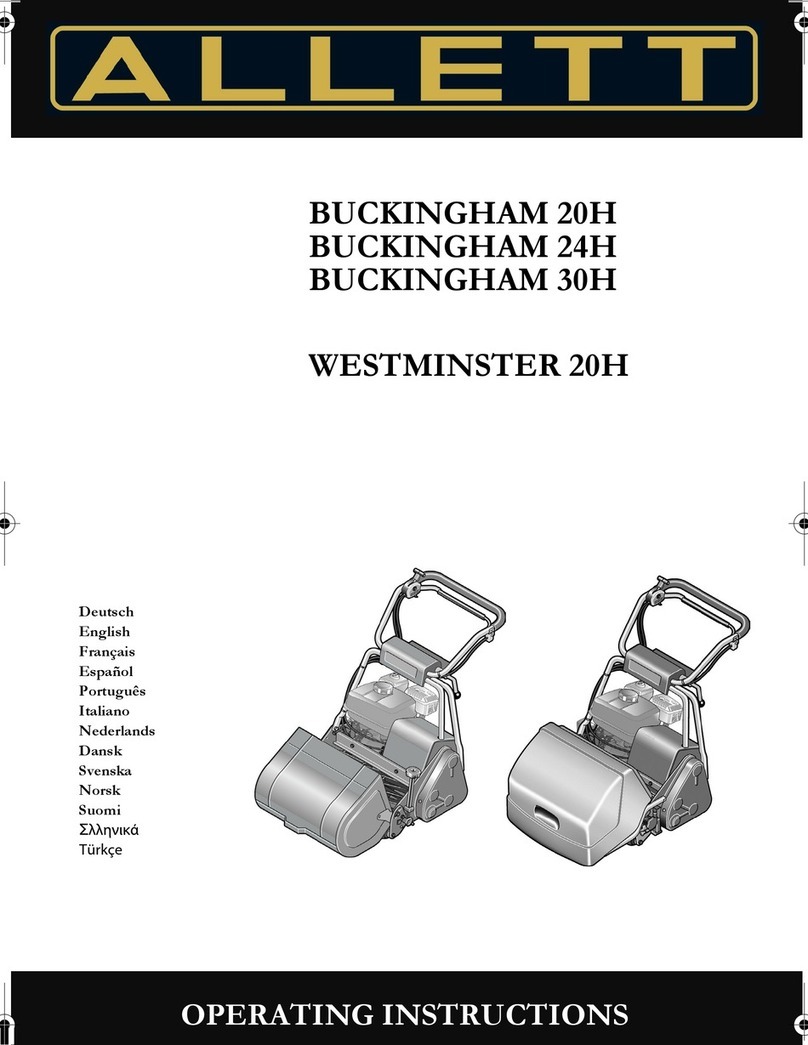
Allett
Allett BUCKINGHAM 20H User manual

Allett
Allett Liberty Classic Push 30cm User manual
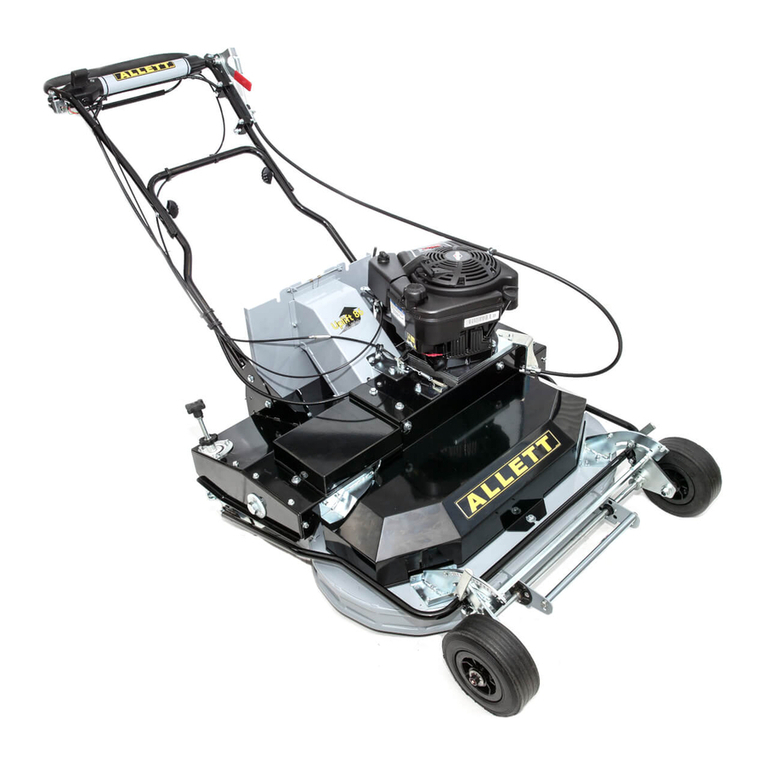
Allett
Allett UPLIFT86 Programming manual

Allett
Allett Kensington 17 User manual

Allett
Allett C 34 Guide

Allett
Allett C 34 User manual
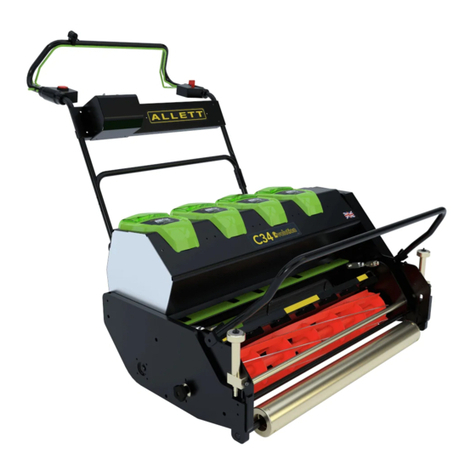
Allett
Allett C 34 User manual

Allett
Allett Liberty Classic Push 30cm User manual

Allett
Allett BUFFALO 24" Product manual
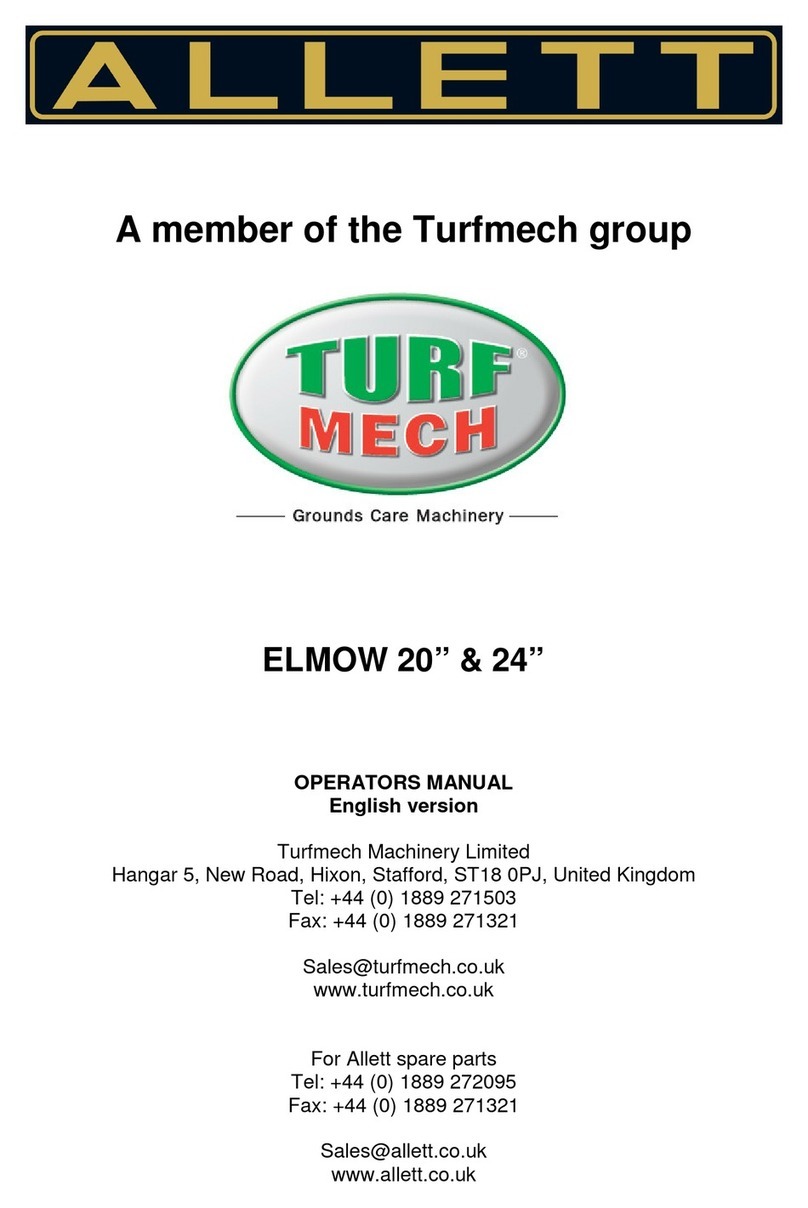
Allett
Allett ELMOW 20 User manual

